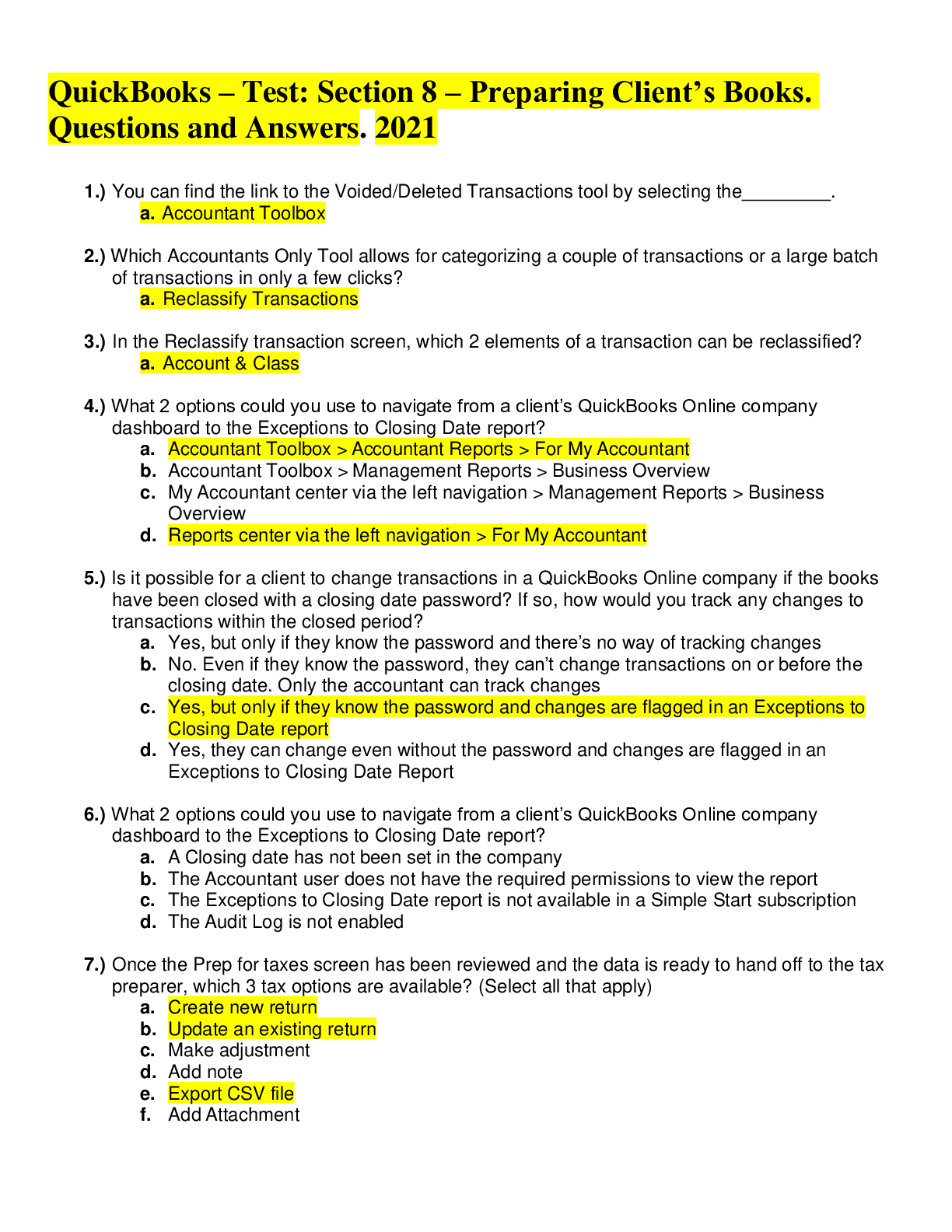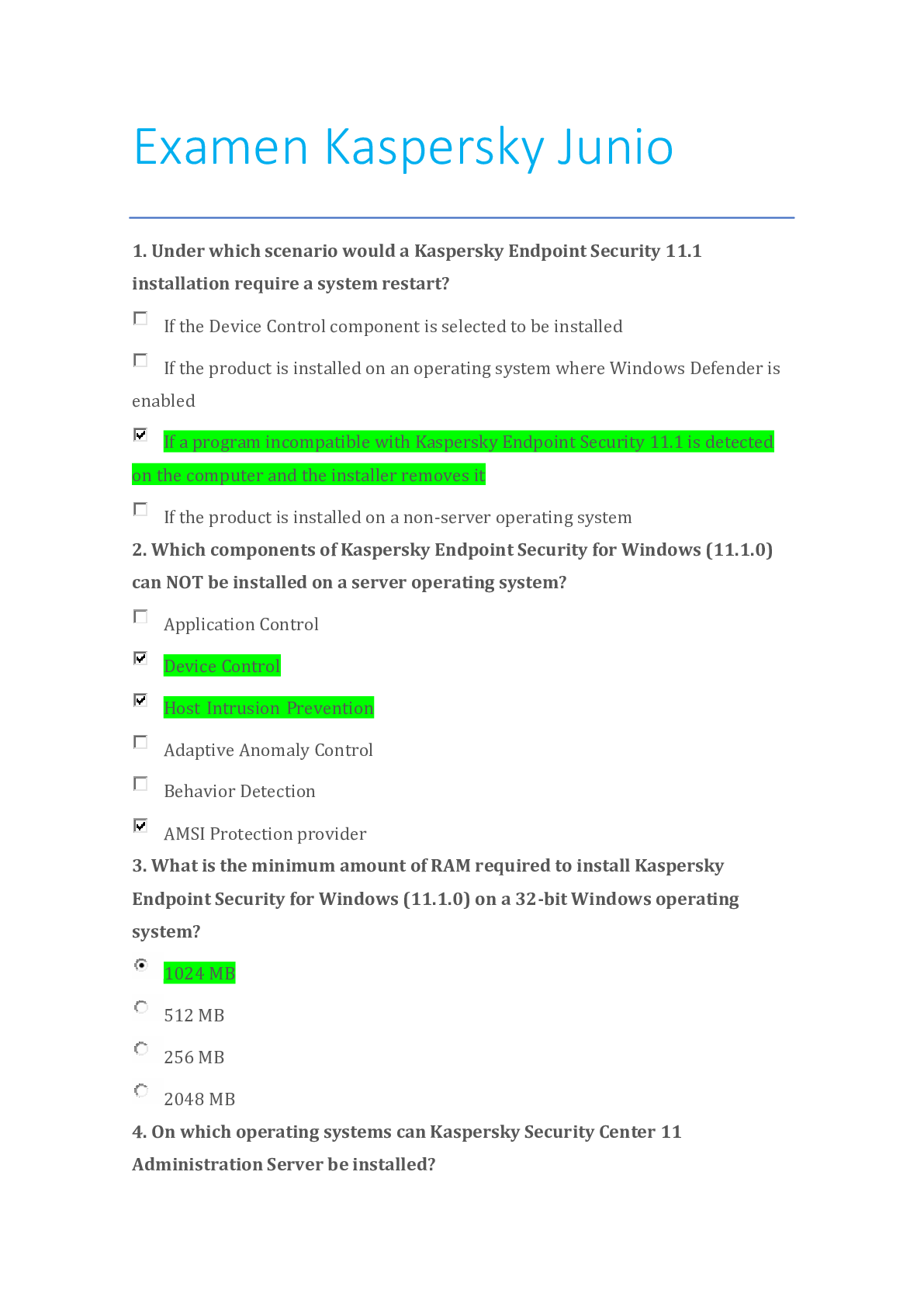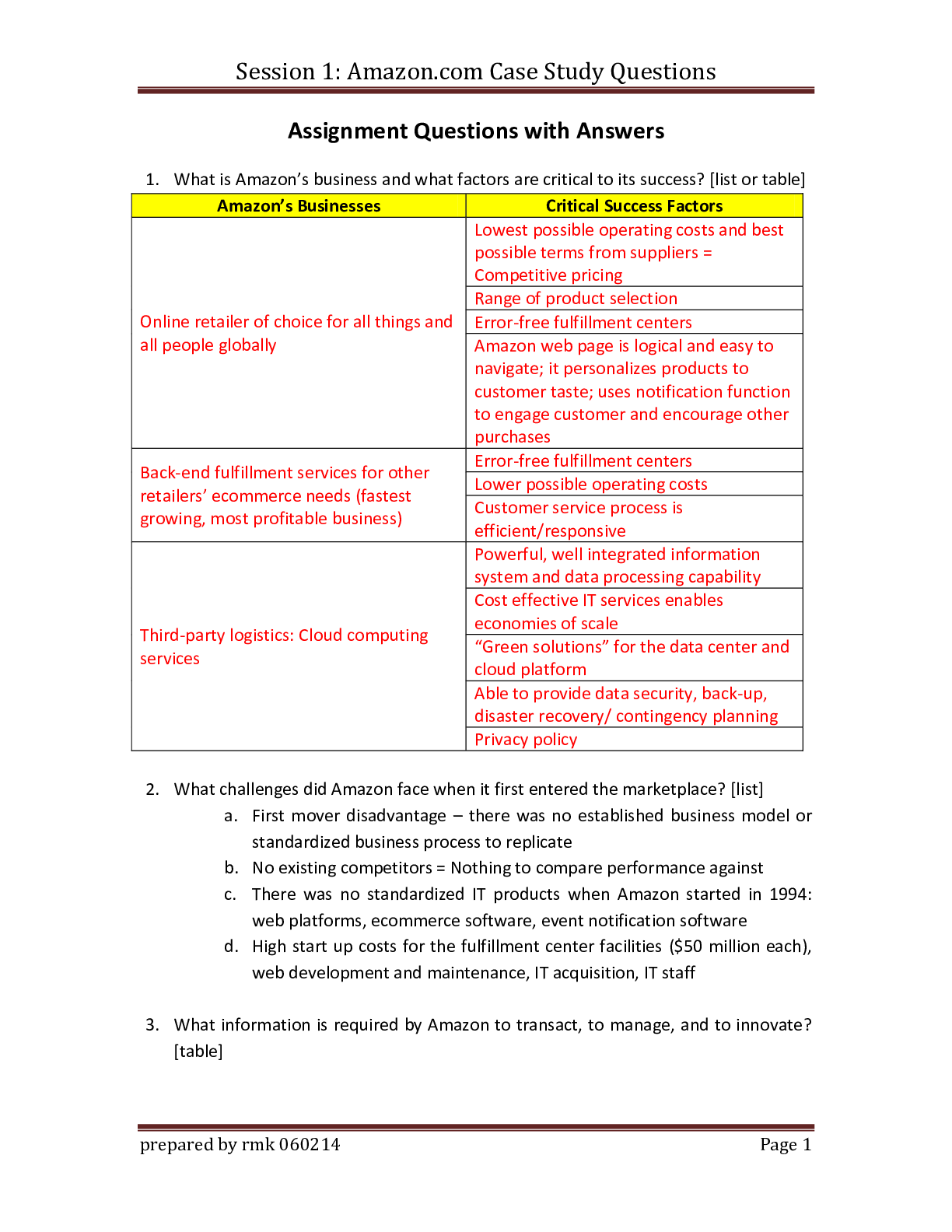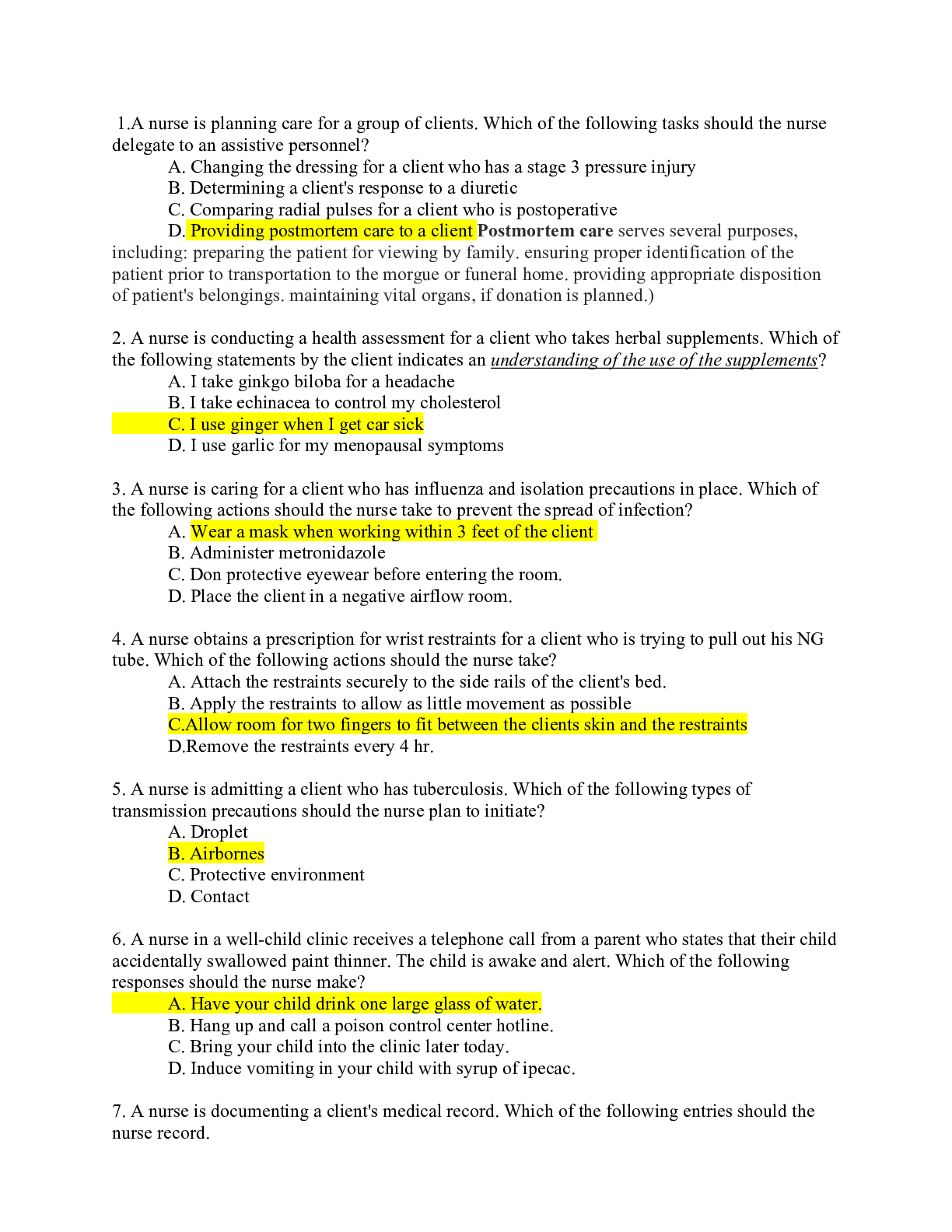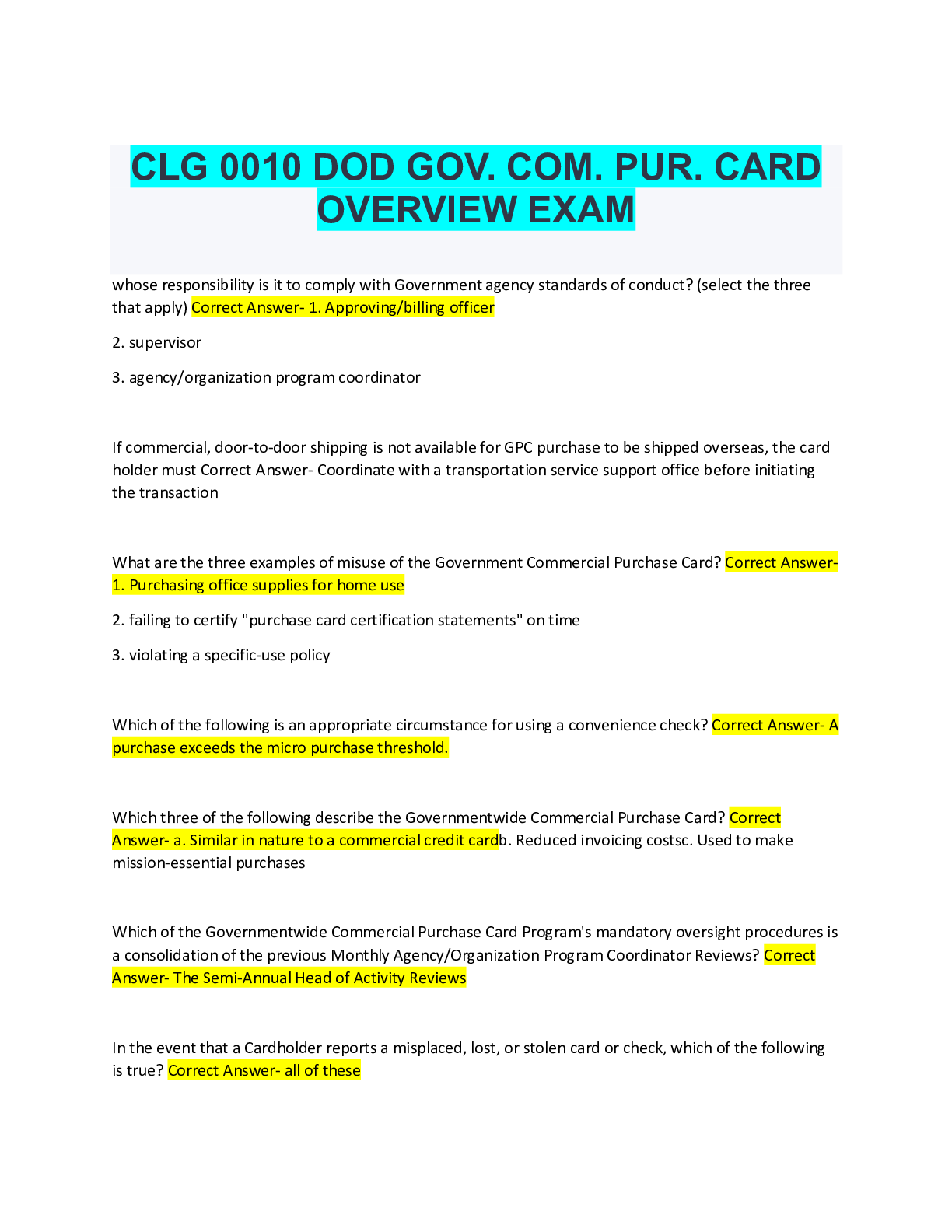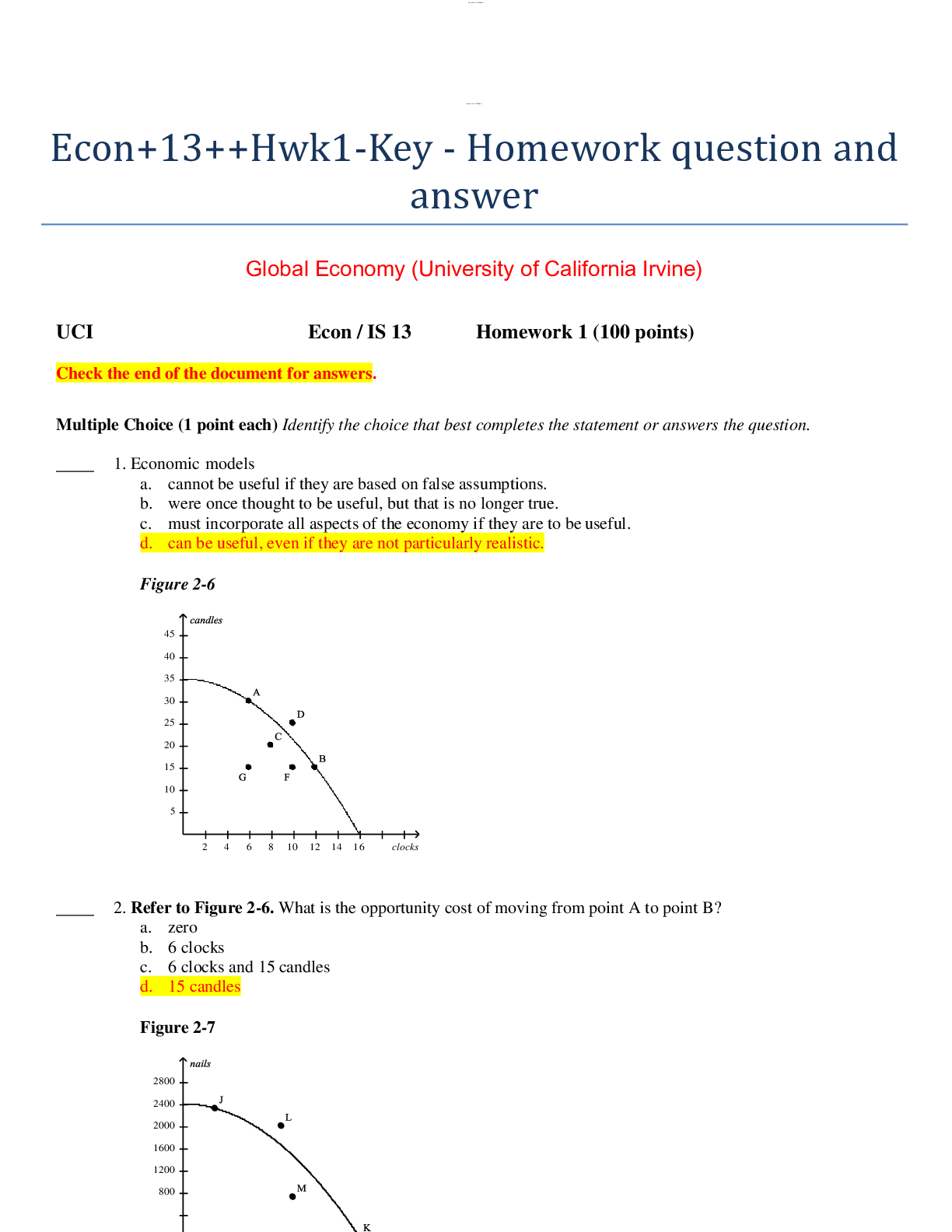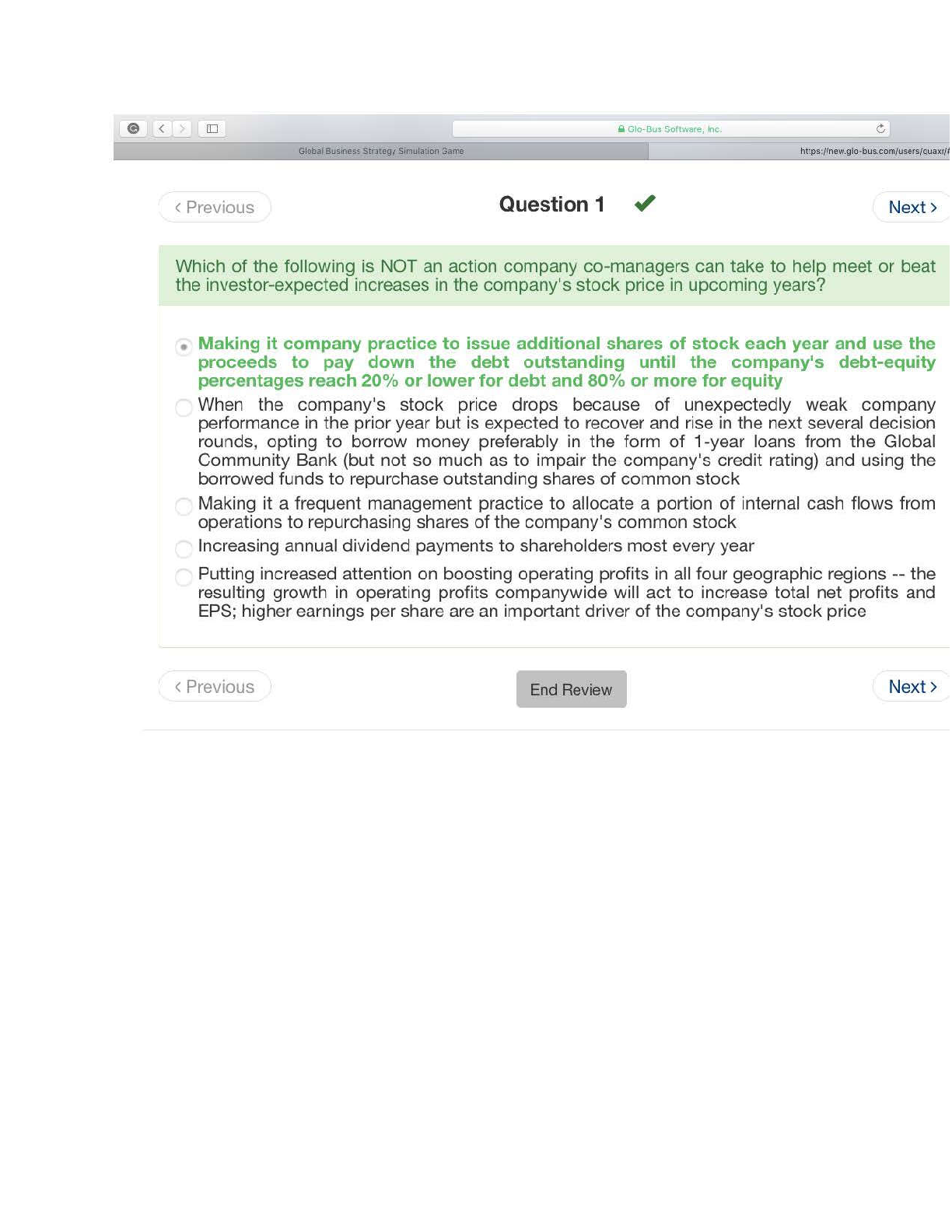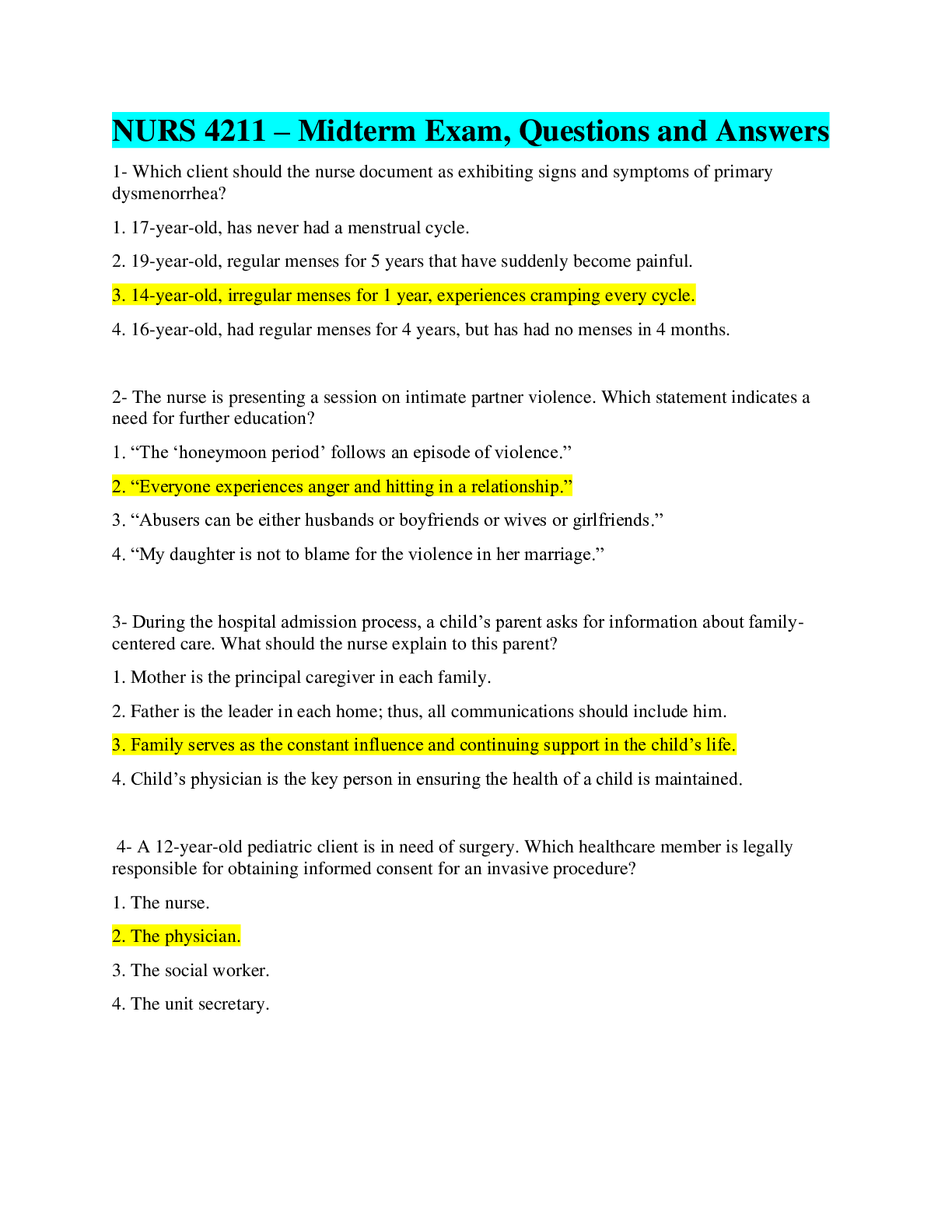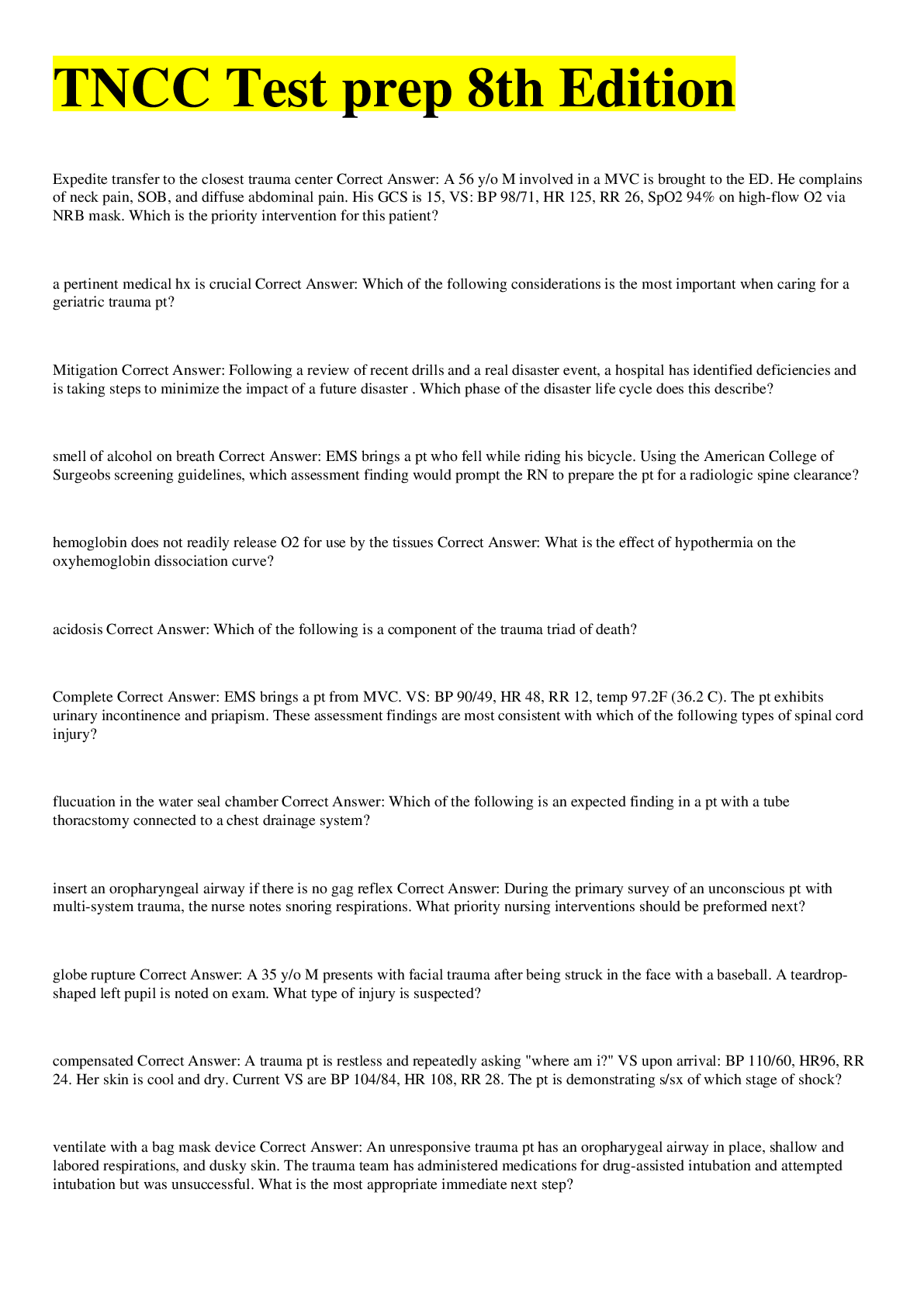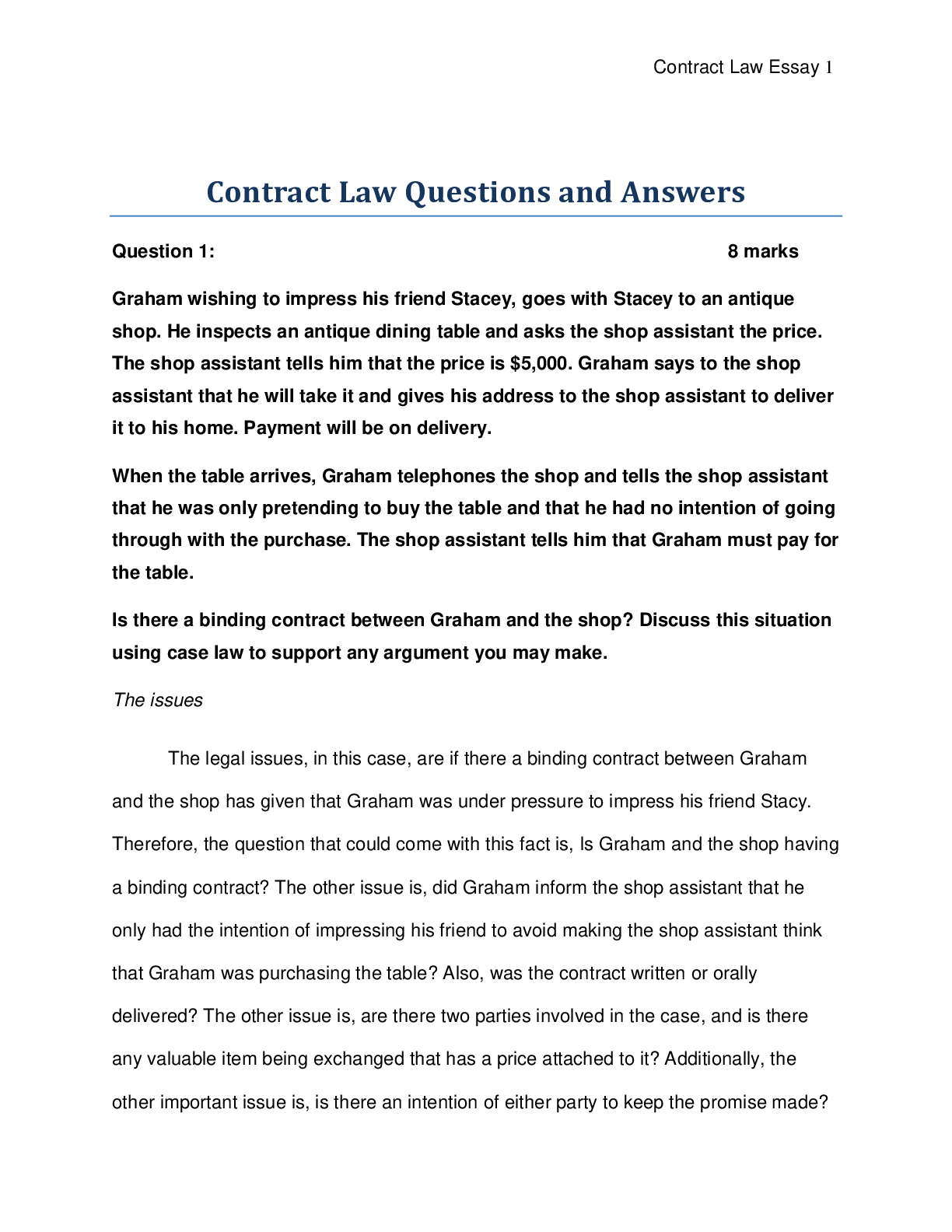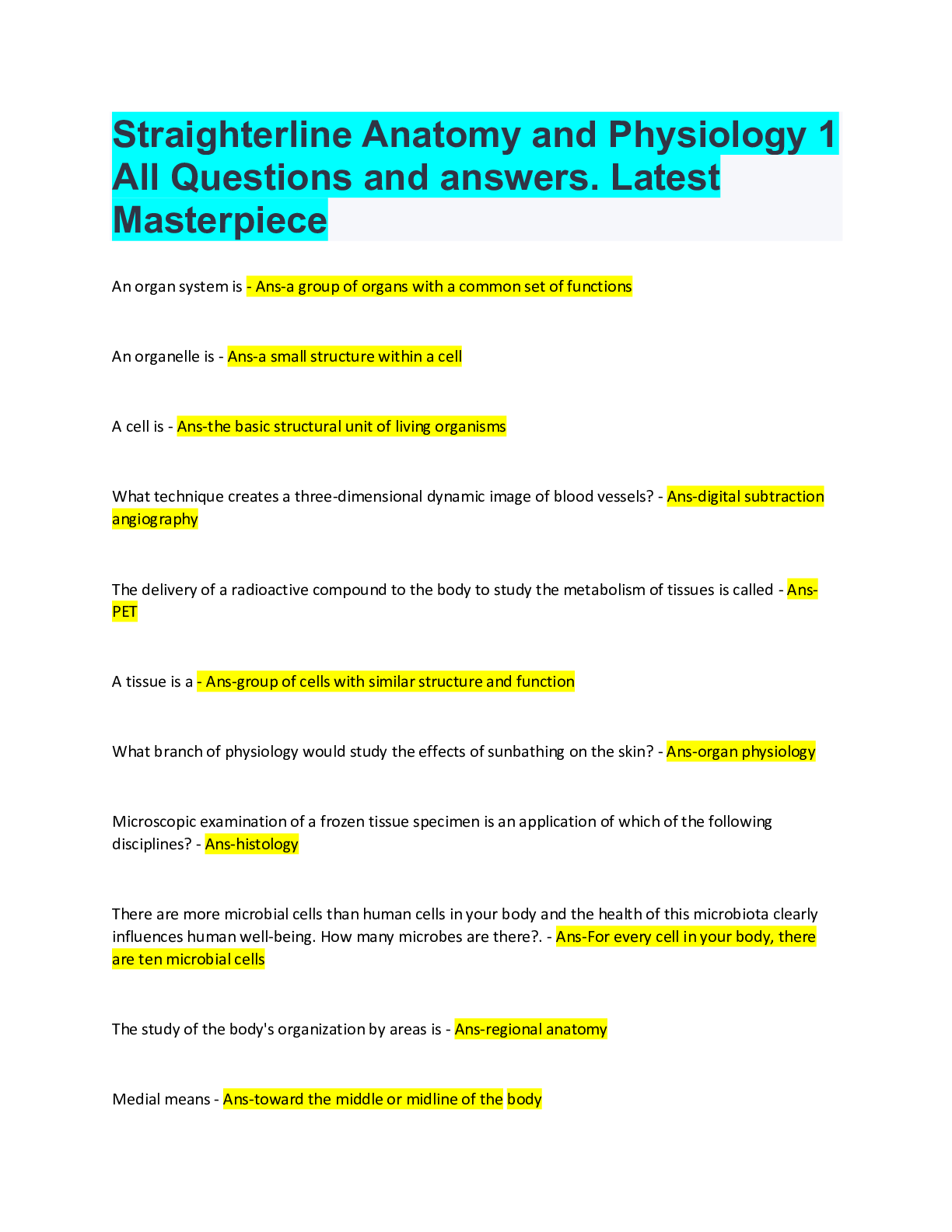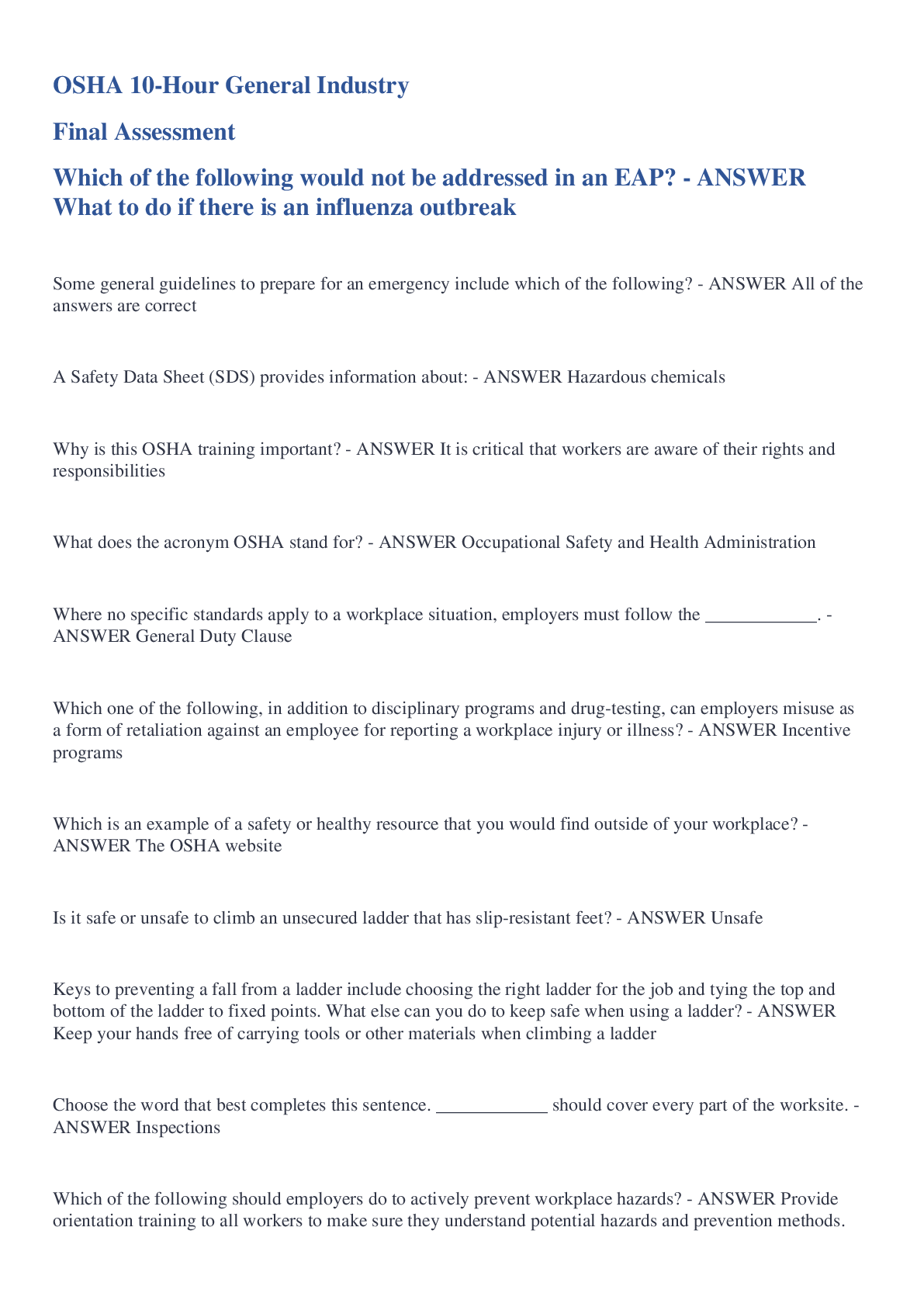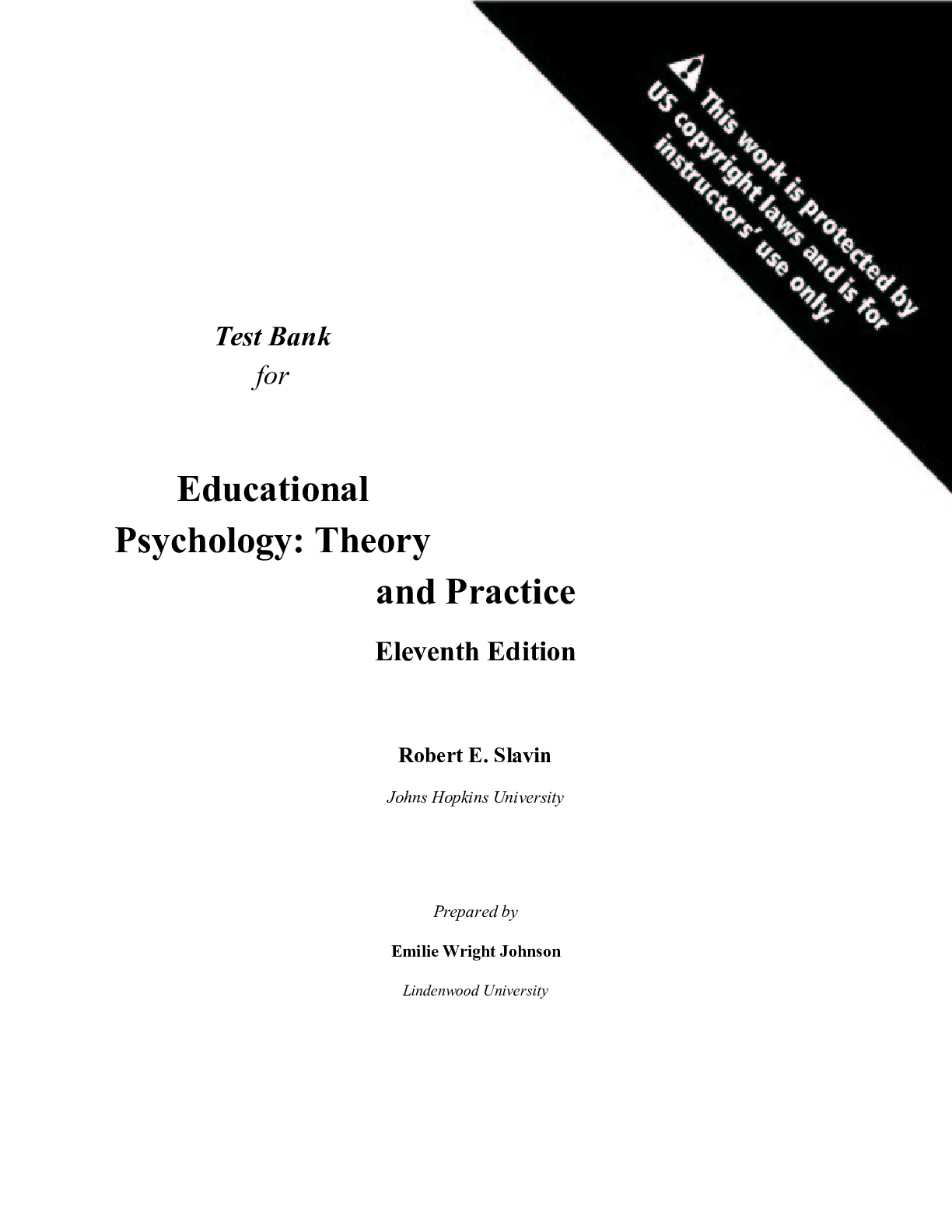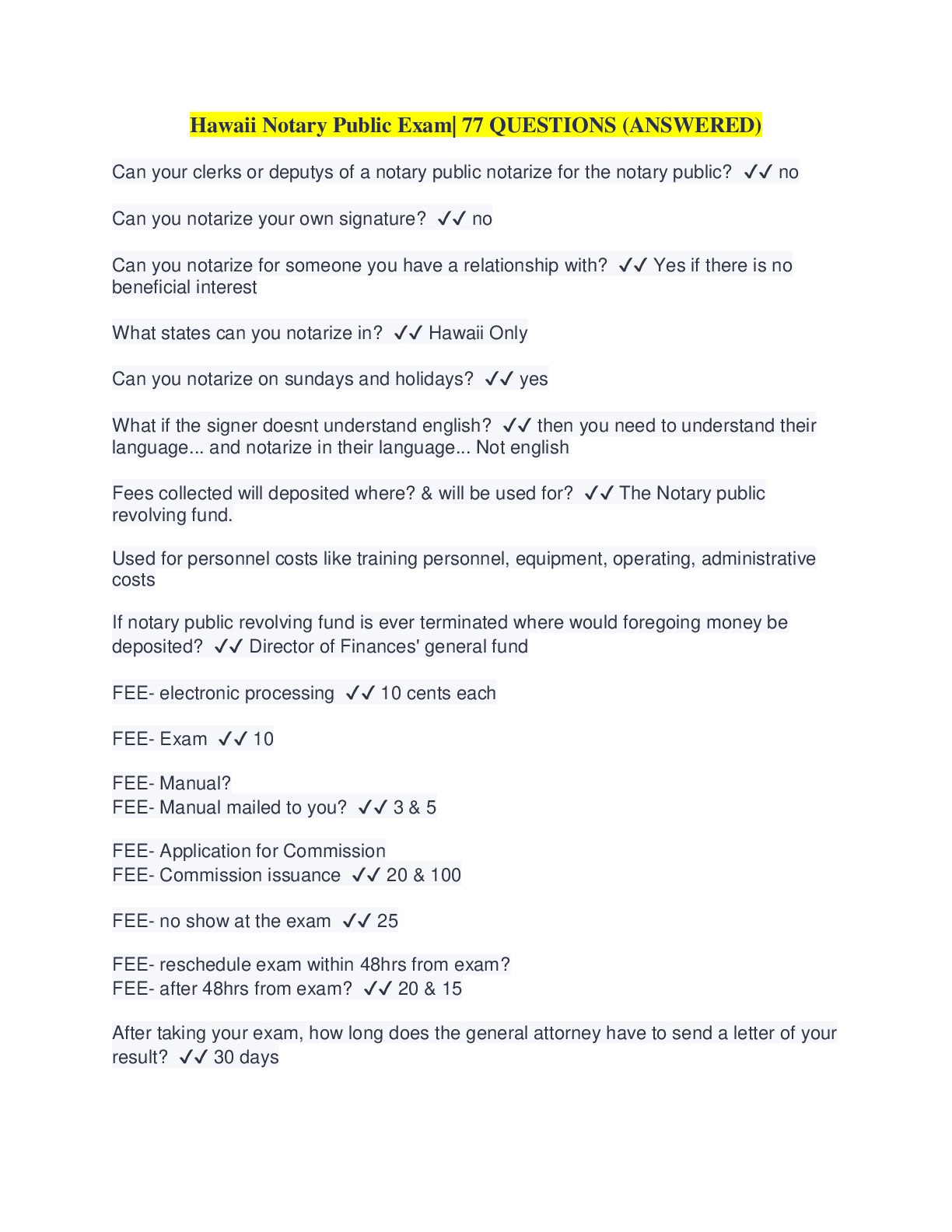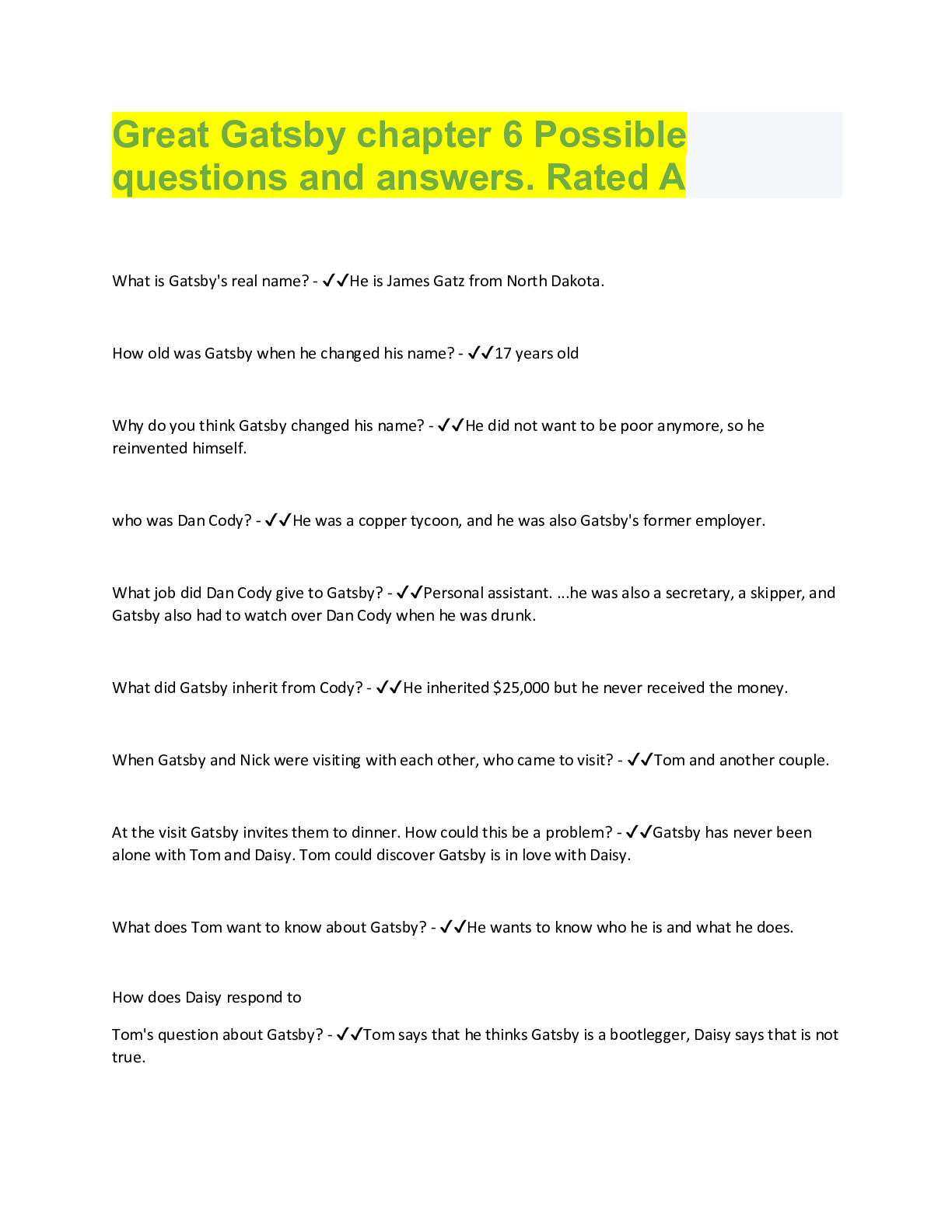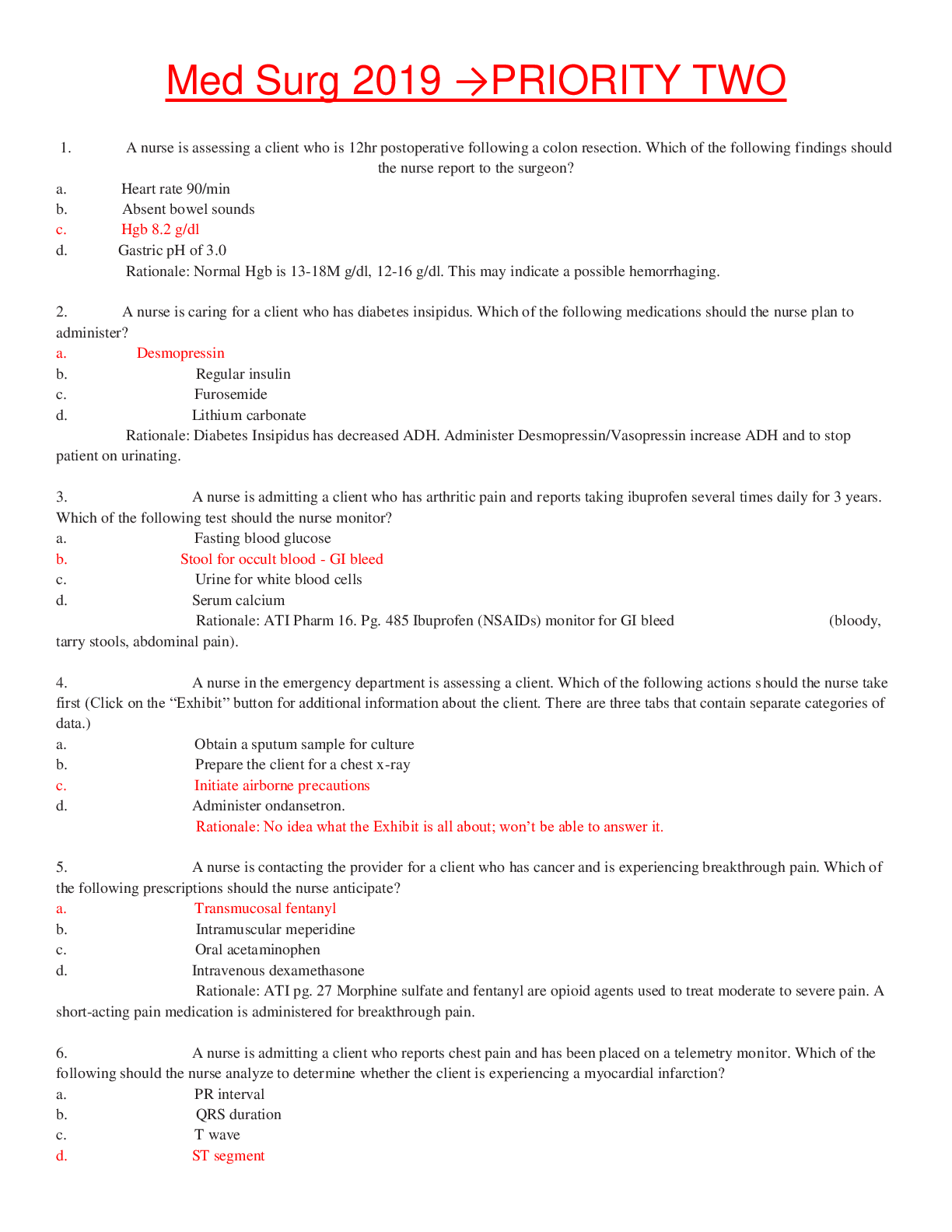Biology > QUESTIONS & ANSWERS > BIOL 1150/1151 Exam 5. Study Guide and Exam Prep. Contains 40 Questions and Answers. (All)
BIOL 1150/1151 Exam 5. Study Guide and Exam Prep. Contains 40 Questions and Answers.
Document Content and Description Below
BIOL1150/1151 Lecture Exam #5 NAME___________________________ 1. The basic subunit of a protein is a: a. monsaccharide b. nucleic acid c. fatty acid d. amino acid 2. Which of these white blood cel... ls gives rise to plasma cells, which can then produce antibodies? a. T lymphocytes b. monocytes c. eosinophils d. B lymphocytes 3. The liquid portion of the blood that consists of about 55% of the total volume of blood is referred to as ________. a. stem cells b. distilled water c. plasma d. platelets 4. A child has a bicycle accident and is rushed to the ER. The doctors stop the bleeding but the child needs a transfusion. Fortunately, the patient is AB positive so the doctors can give him ________. a. AB negative or positive only b. any blood type c. O positive only d. O negative only 5. If a disease attacked this type of white blood cell, a person would no longer be able to mobilize his or her specific defenses. a. plasma cells b. helper T lymphocytes c. cytotoxic T lymphocytes d. B lymphocytes 6. Any substance that triggers an immune response in the body is called a(n) ________. a. MHC marker b. memory cell c. antigen d. complement 7. Which antibody has a 5-sided arrangement and is usually the first antibody released in response to an infection ? a. IgA b. IgD c. IgM d. IgG 8. Allergens combine with IgE to cause mast cells to release an inflammatory chemical called________. a. interferon b. histamine c. plasma cells d. interleukin I 9. Descendant cells that are long-lived and "remember" a particular invader and mount a rapid intense response to it if it should reappear are ________. a. macrophage b. memory cells c. suppressor cells d. helper cells 10. Why are severe burn patients at extreme risk of infection? a. The skin is the first and primary barrier to preventing ingress of foreign substances. b. These patients have to stay in a hospital environment for a long time while being exposed to sick people. c. Most immune system cells are destroyed when the skin is damaged. d. The skin helps with the production of vitamin E, a necessary disease-fighting vitamin. The maximum amount of air that can be moved into and out of the lungs during forceful breathing is called ________. a. tidal volume b. residual volume c. vital capacity d. total lung capacity 12. The amount of air inhaled or exhaled during a normal breath is ________. a. vital capacity b. residual volume c. tidal volume d. total lung capacity 13. Which of the following is a thin-walled, rounded chamber surrounded by a vast network of capillaries? a. Alveolus b. Glottis c. Diaphragm d. Surfactant 14. If oxygen is present, our cells can make ________ATP? a. slightly more b. significantly more c. slightly less d. significantly less e. the same amount 15. Fever is a component of ___________? a. the innate immune response b. the adaptive immune response 16. If Joan has her gall bladder removed, her body will no longer be able to concentrate what substance? a. stomach acid b. feces c. bile d. hemoglobin 17. If a person were unable to produce much of this substance, the gastric juices might destroy the stomach lining. a. chime b. HCl c. mucus d. pepsin 18. What is the importance of consuming adequate amounts of protein in the diet? a. Proteins are necessary to produce urea and other metabolites b. Proteins are the most common input molecules for aerobic respiration c. Proteins are commonly utilizes as co-enzymes in biochemical reactions d. Proteins serve a variety of structural and enzymatic functions in the body 19. The basic subunit of a lipid is a: a. monsaccharide b. nucleic acid c. fatty acid d. amino acid Three groups of cyclists consumed three different types of diets indicated above as highcarbohydrate, protein/fat, and mixed. The average time the group could spend cycling over a 6-hour period is shown in the above graph. How could an athlete or trainer use the data to improve performance? a. Diet is not appear to be related to cycling endurance at all b. An early and dramatic drop in glucose is related to improved cycling endurance c. Cycling endurance is likely only related to diet d. Maintaining elevated blood sugar improves cycling endurance 21. One function of mechanical digestion is to break large food pieces into smaller pieces. Why is this important during digestion? a. Small pieces of food are easier to excrete b. Smaller pieces of food are more easily stored in the stomach c. Smaller pieces of food have more surface area leading to more efficient chemical digestion d. Smaller pieces of food do not taste as good 22. Which of the following nutrient molecules would you expect to be absorbed into the lumen of the small intestine through simple diffusion? a. Small lipids b. Disaccharides c. Large carbohydrates d. Proteins 23. If Jane is Rh- and her husband is Rh+, she may need to be concerned for her second child if_____? a. her first child is Rh- b. her first child is Rh+ 24. When a patient has their gall bladder removed, which of the following nutrients would a doctor recommend they consume in smaller amounts? a. Carbohydrates b. Proteins c. Lipids d. Nucleic Acids 25. If you placed a piece of white bread (high in carbohydrates) on your tongue and let it dissolve you would begin to taste __________ due to the action of the enzyme salivary amylase. a. Sweet b. Sour c. Salty d. Spicy . What prevents food from going down the trachea? a. Tongue b. Esophagus c. Epiglottis d. Glottis 27. Which of the following chemical nutrients is initially broken down by enzymes in the mouth? a. Carbohydrates b. Proteins c. Lipids d. Nucleic Acids 28. Cancerous cells routinely form within our body. Natural killer cells are responsible for destroying them. a. True b. False 29. O2 and CO2 enter and exit the bloodstream from the lungs through the process of ______. a. Facilitated diffusion b. Simple diffusion c. Osmosis d. Active transport 30. What is the extracellular matrix (ECM) in blood called? a. Leukocytes b. Erythrocytes c. Platelets d. Plasma 31. The Pimas are a group of people who live in the Southwestern United States and Mexico. Although Pima Indians have a similar genetic background, those living in the U.S. have seen a five-fold increase in the cases of Type II diabetes. Based on the above graph, what can you infer? a. People who develop Type II diabetes are typically diagnosed at adolescence b. The incidence of Type II diabetes had increased over the past several years c. Obesity is a risk factor for Type II diabetes d. If you maintain normal body weight (<25) you will not get Type II diabetes 32. Which of the following components of blood is primarily responsible for clotting? a. Neutrophils b. platelets c. T cells d. Red blood cells Which of the following is considered an accessory organ to the alimentary canal (digestive tract)? a. stomach b. small intestine c. gall bladder d. esophagus 34. What is the metal in the center of the hemoglobin molecule? a. magnesium b. calcium c. iron d. lead 35. Which organ in the digestive tract is responsible for the absorption of most nutrients from our food? a. stomach b. small intestine c. esophagus d. large intestine SHORT ANSWER (Pick 3): 1. For each of the ABO blood types: A, B, AB, and O, list what ABO surface antigens they possess AND what ABO antibodies they would produce. Which blood type is the Universal Donor. Explain why this is the case using antigen/antibody terminology. 2. List five different blood cells produced by the body. Briefly describe a function of each. 3. Explain, in detail, the major difference in the innate and adaptive immune responses including how they react to pathogens and the major molecular/cellular/tissue players in each. 4. List the 5 classes of immunoglobulins and provide a brief description of the identifying properties of each. 5. Draw and label the organs of the digestive tract in their correct order. In writing, provide a brief explanation for the role of each. 6. Explain the similarities and differences between vitamins and minerals in our diet and describe the role that the members of these two groups play in our bodies. [Show More]
Last updated: 1 year ago
Preview 1 out of 6 pages
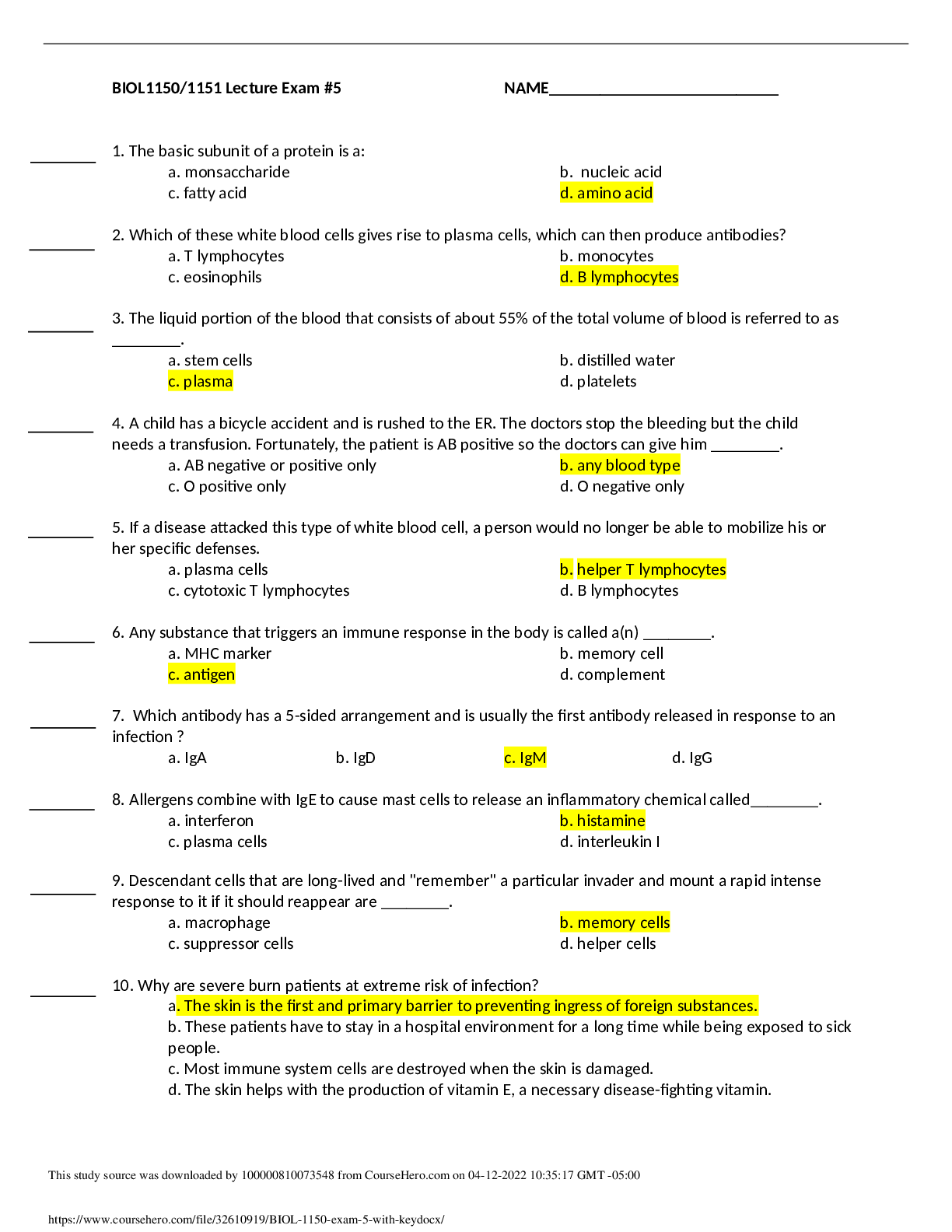
Reviews( 0 )
Document information
Connected school, study & course
About the document
Uploaded On
Apr 12, 2022
Number of pages
6
Written in
Additional information
This document has been written for:
Uploaded
Apr 12, 2022
Downloads
0
Views
54

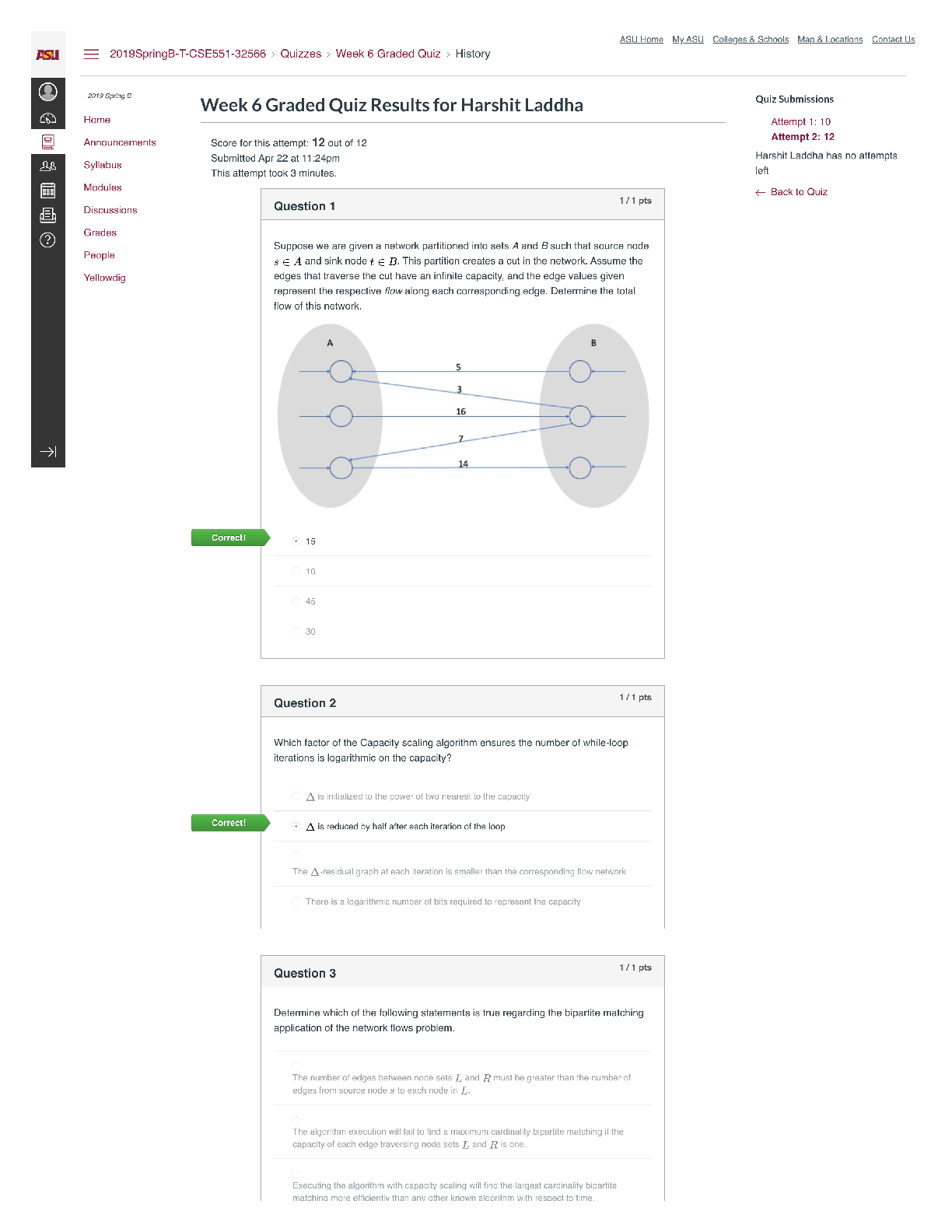

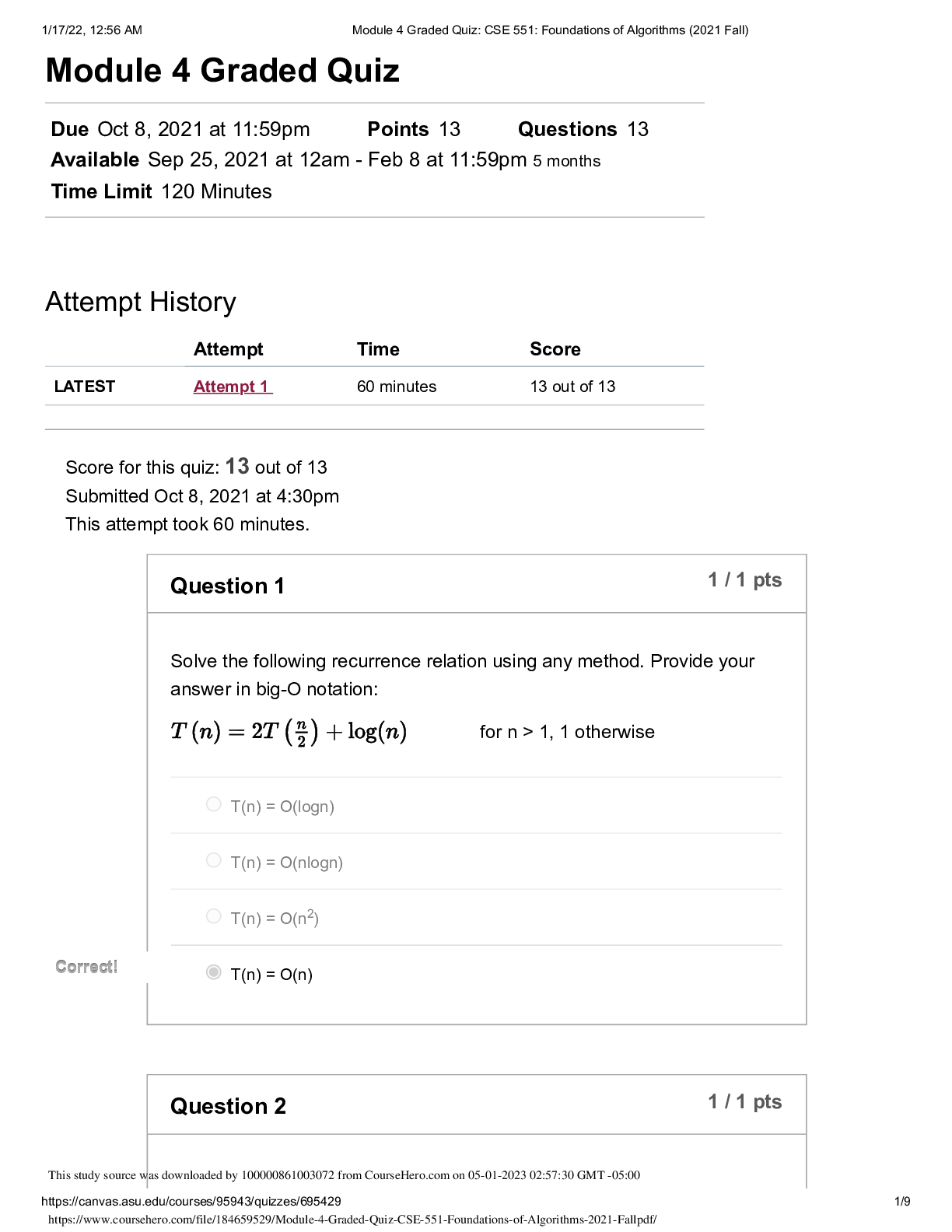
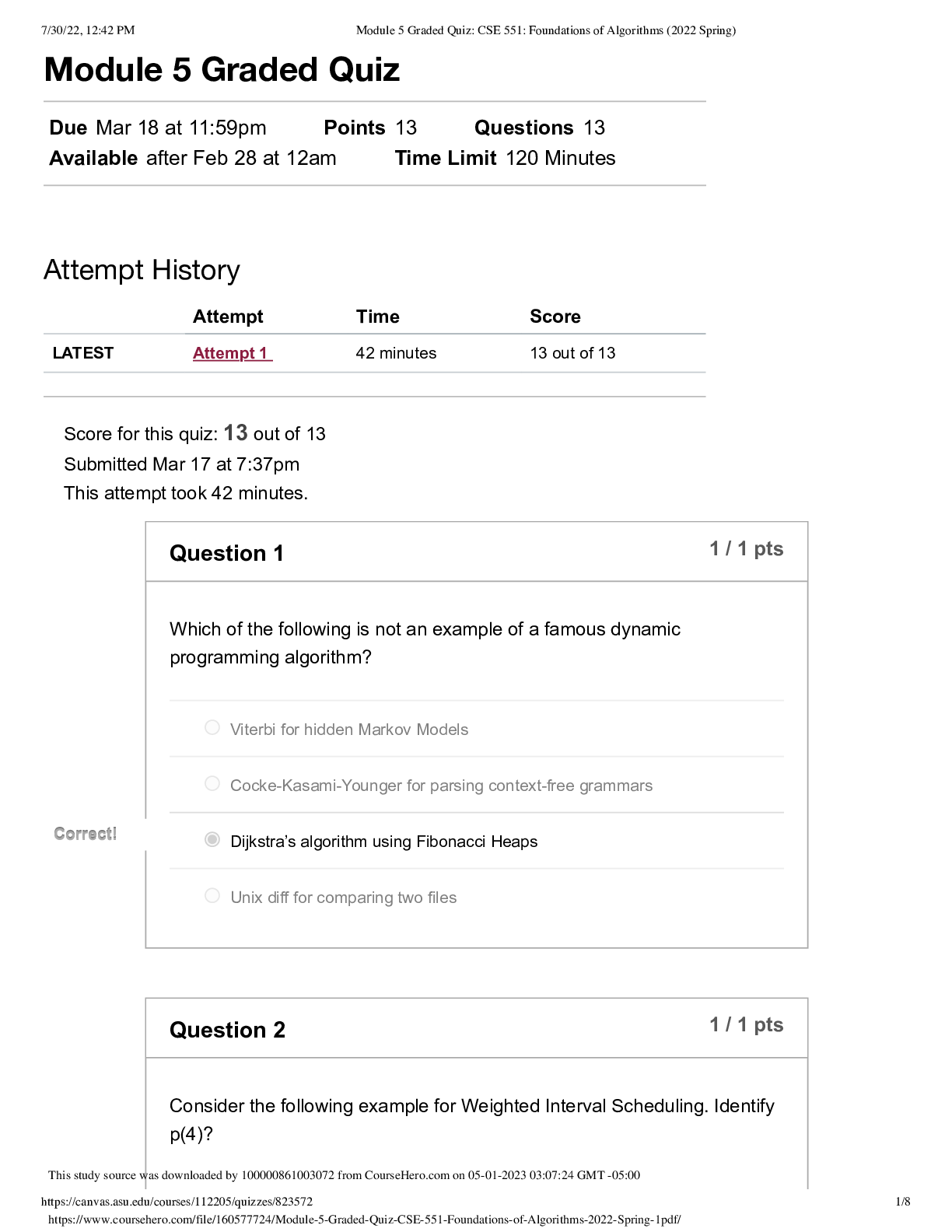
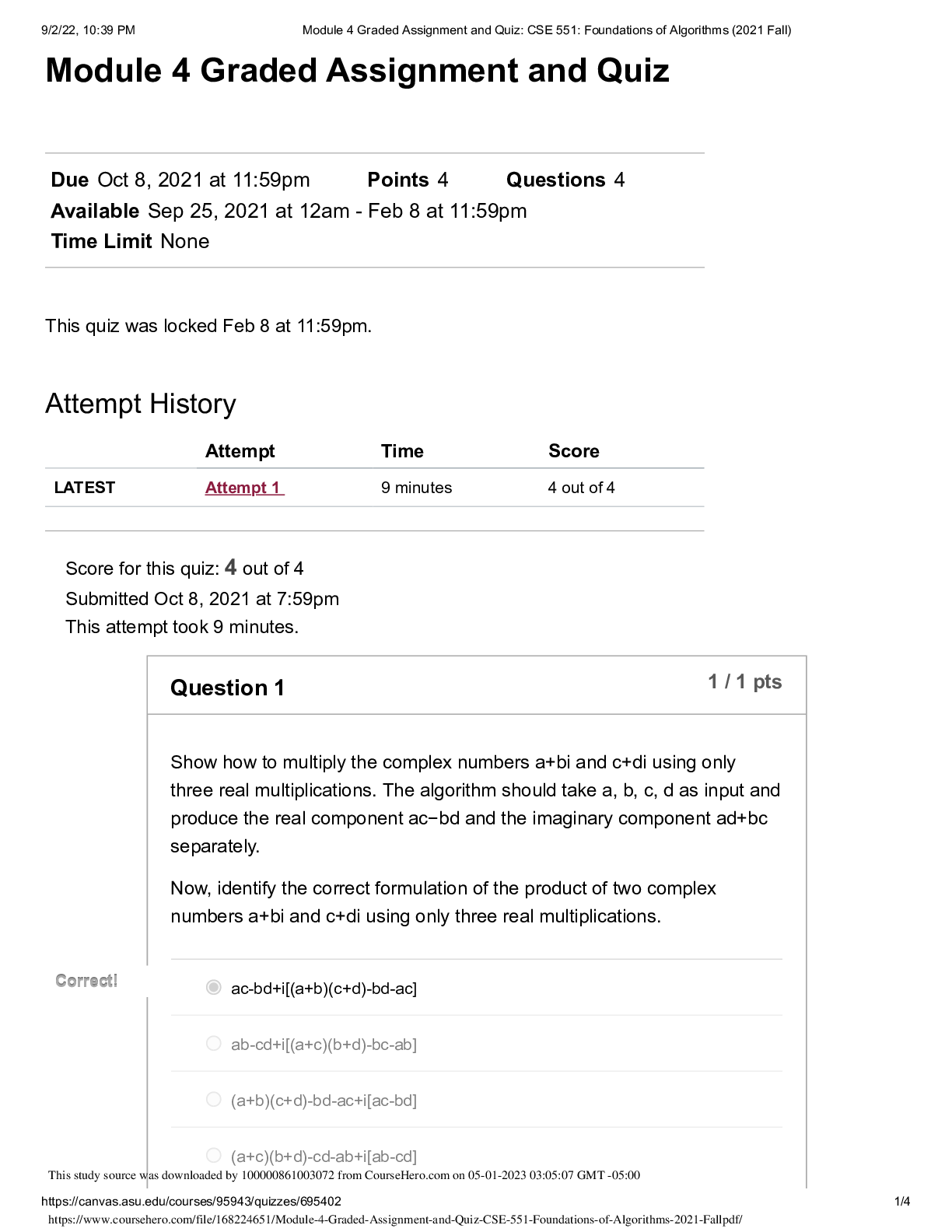
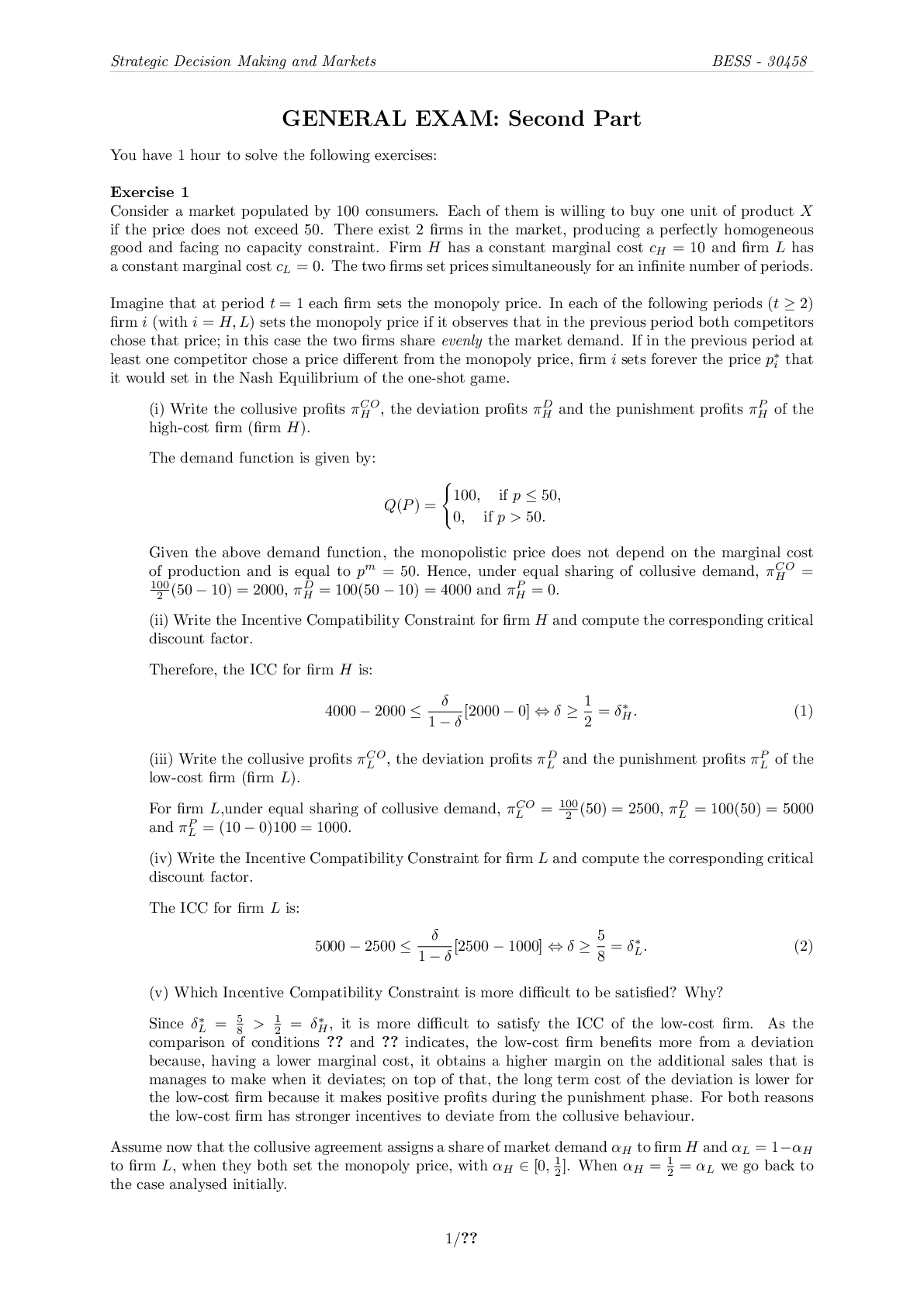

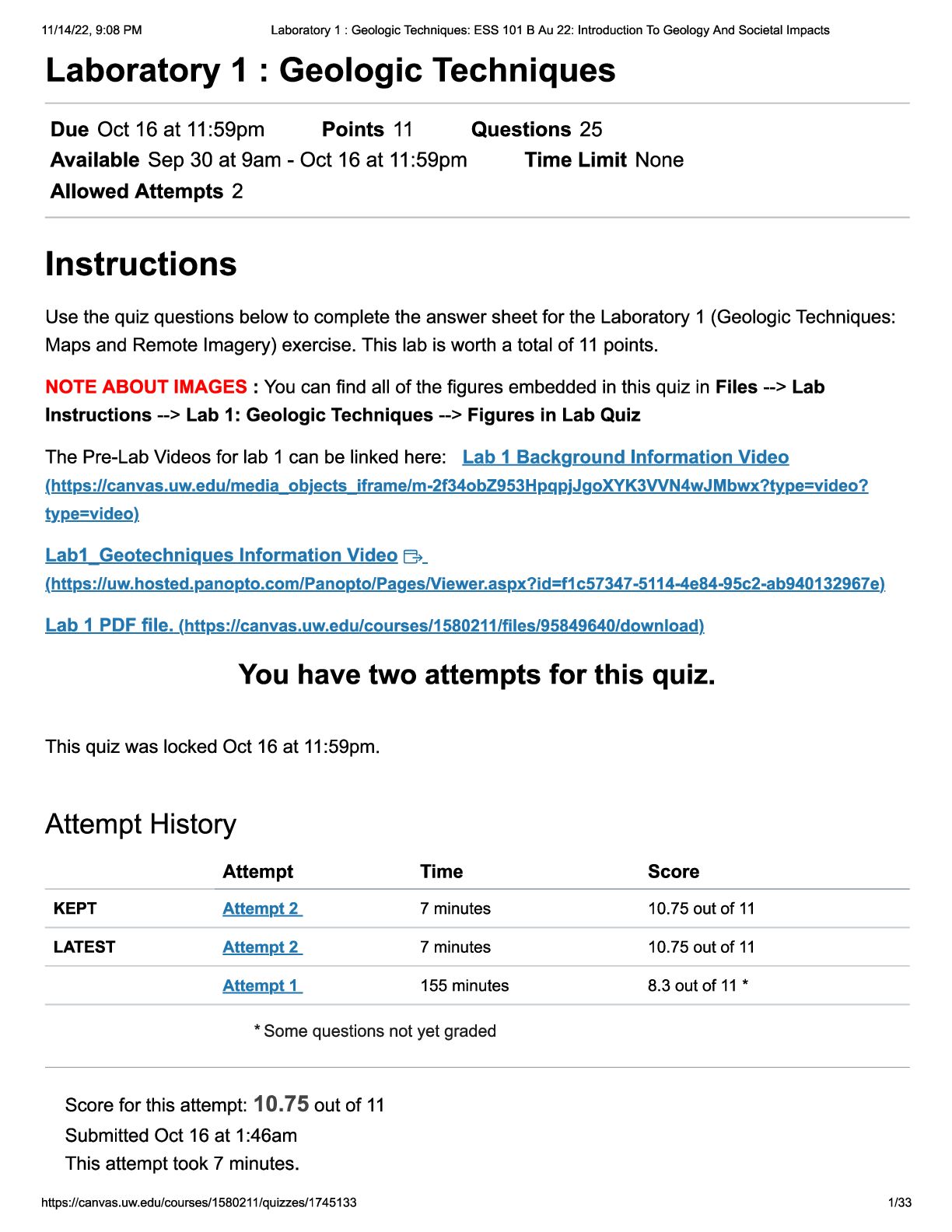

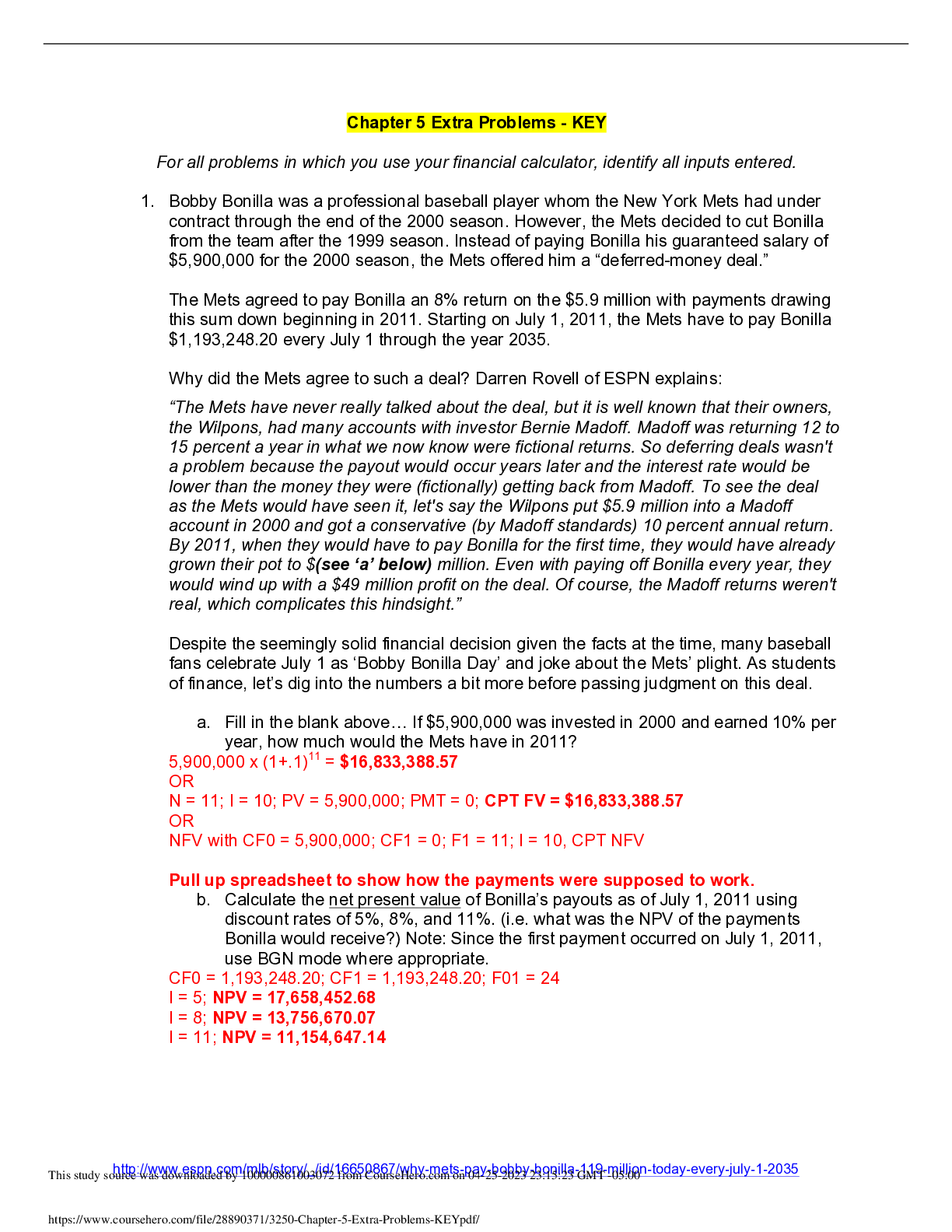




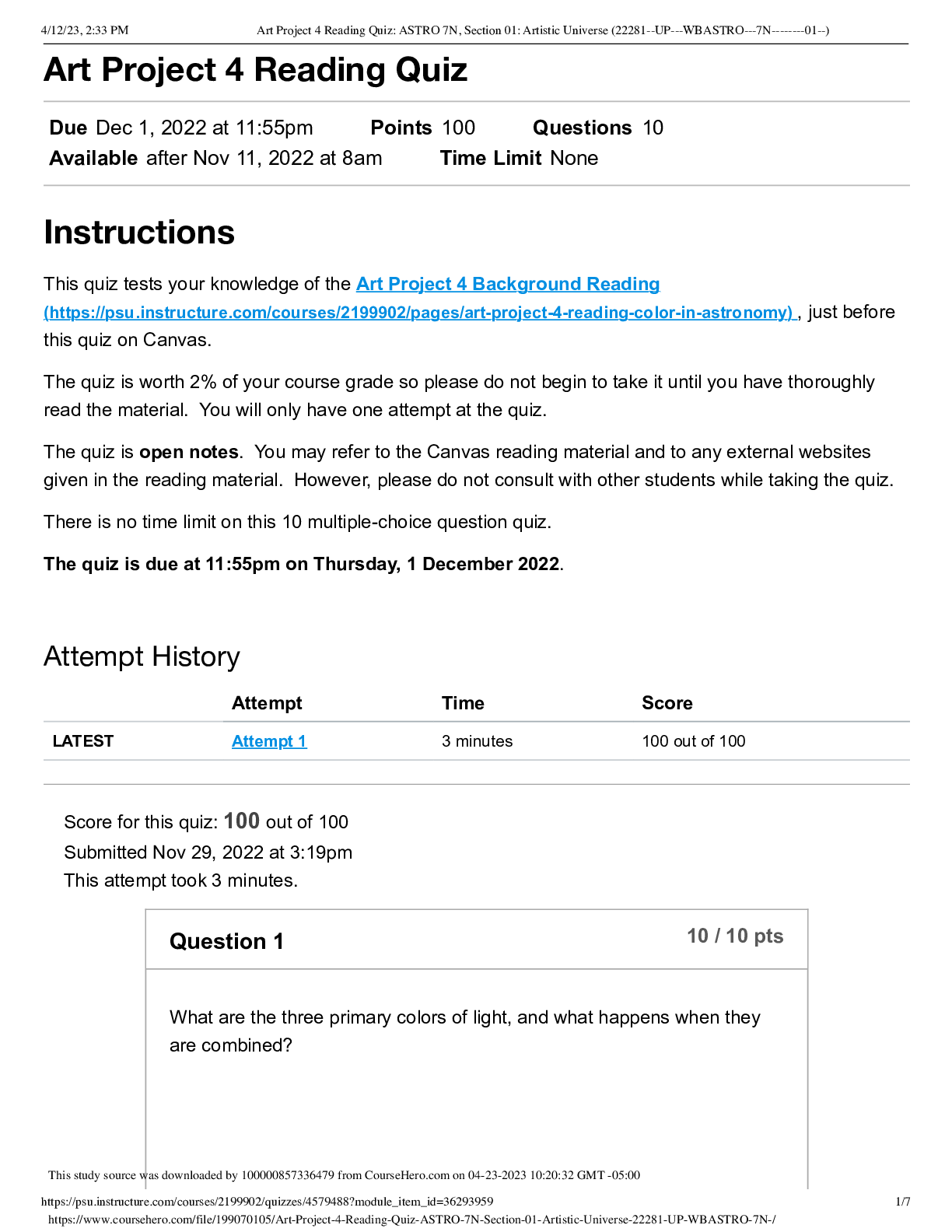
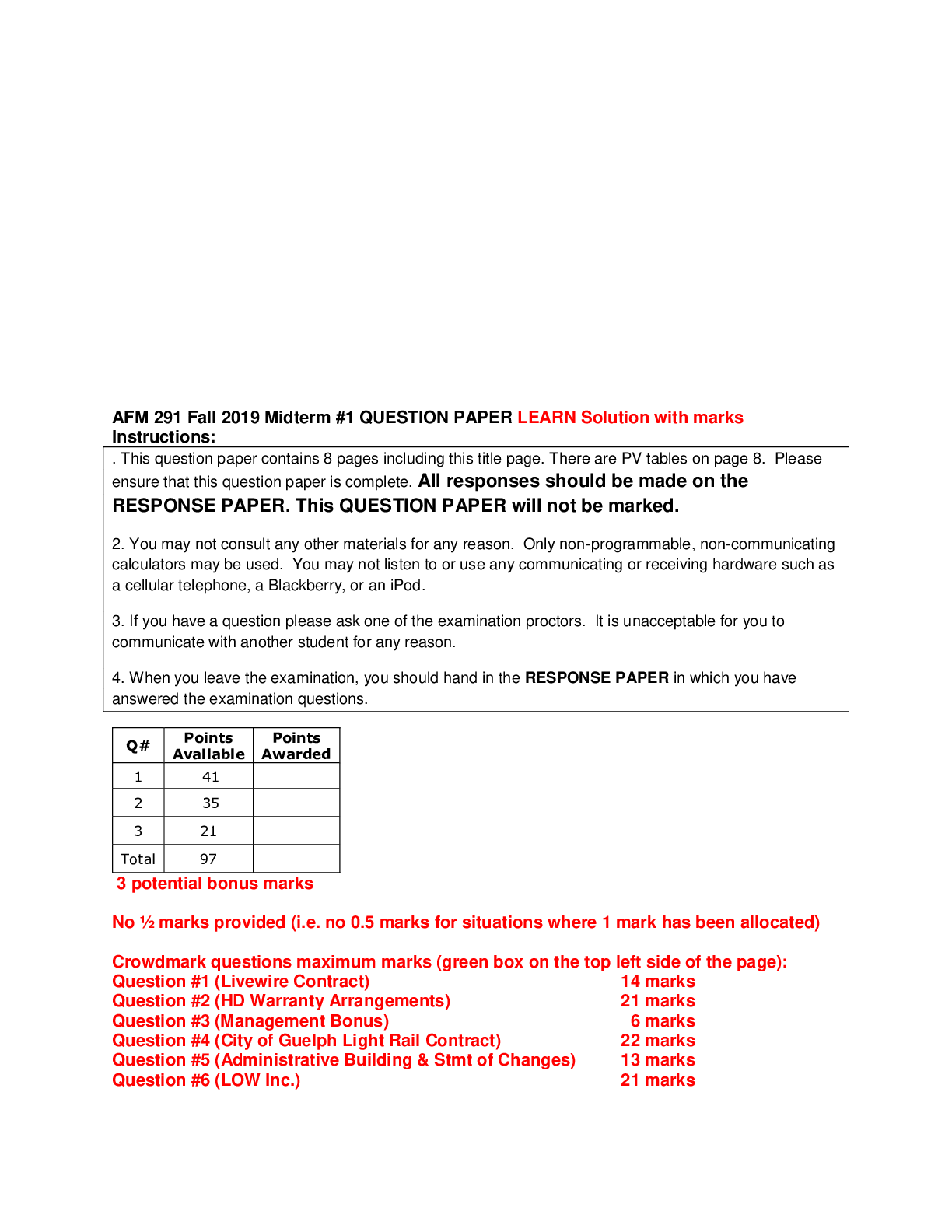

.png)


